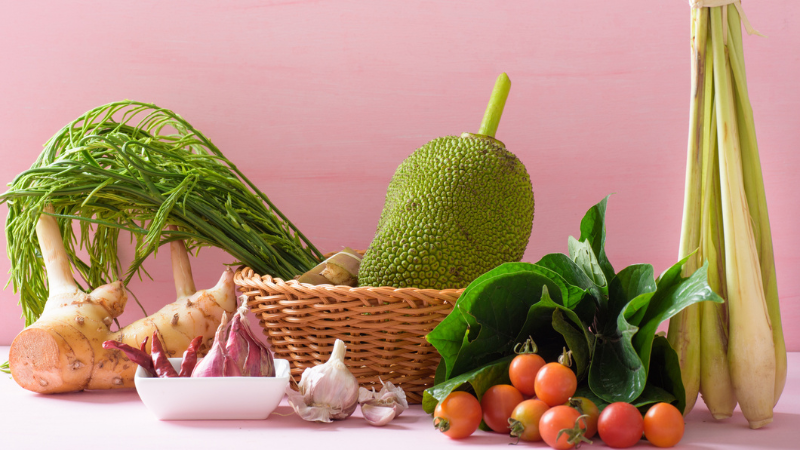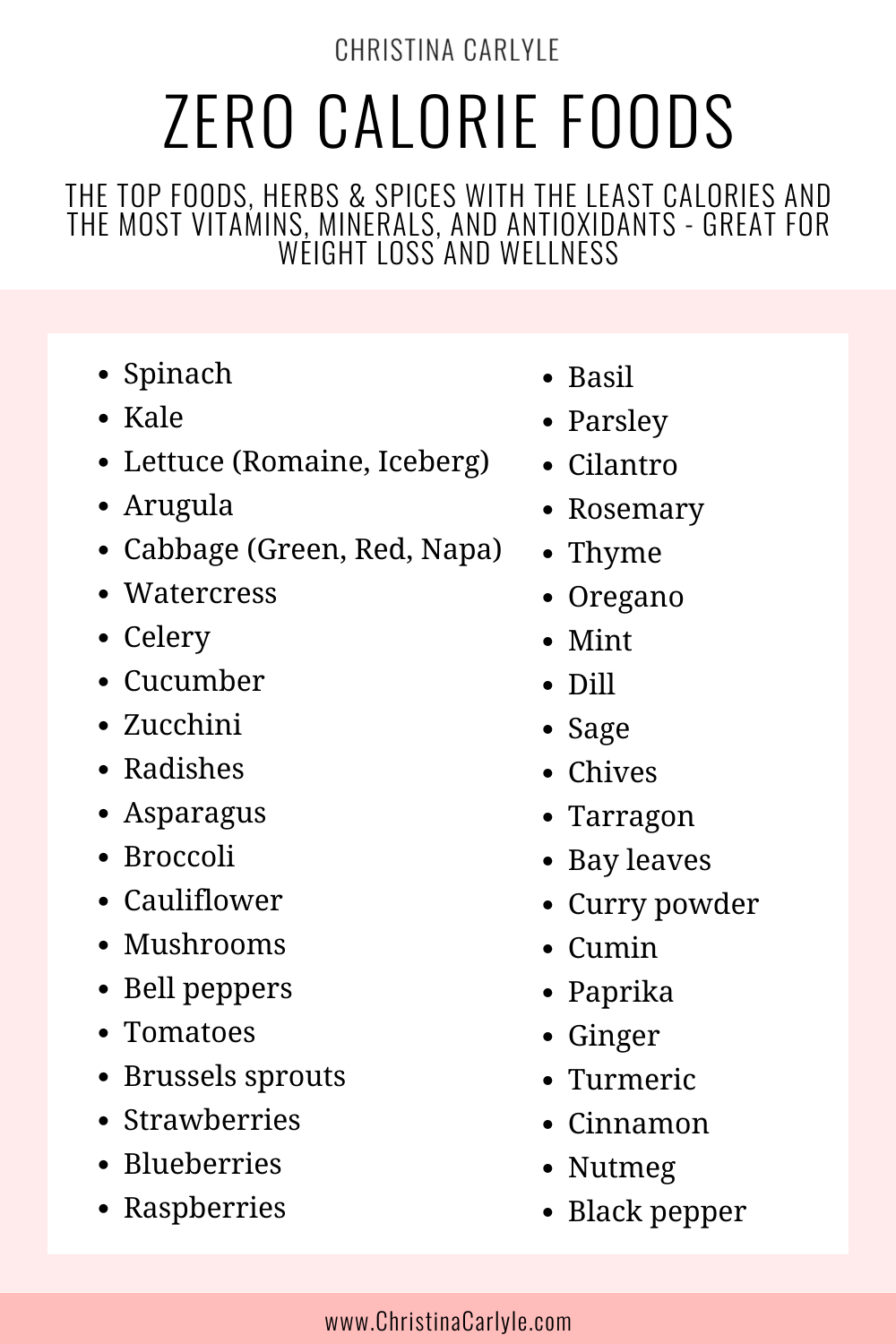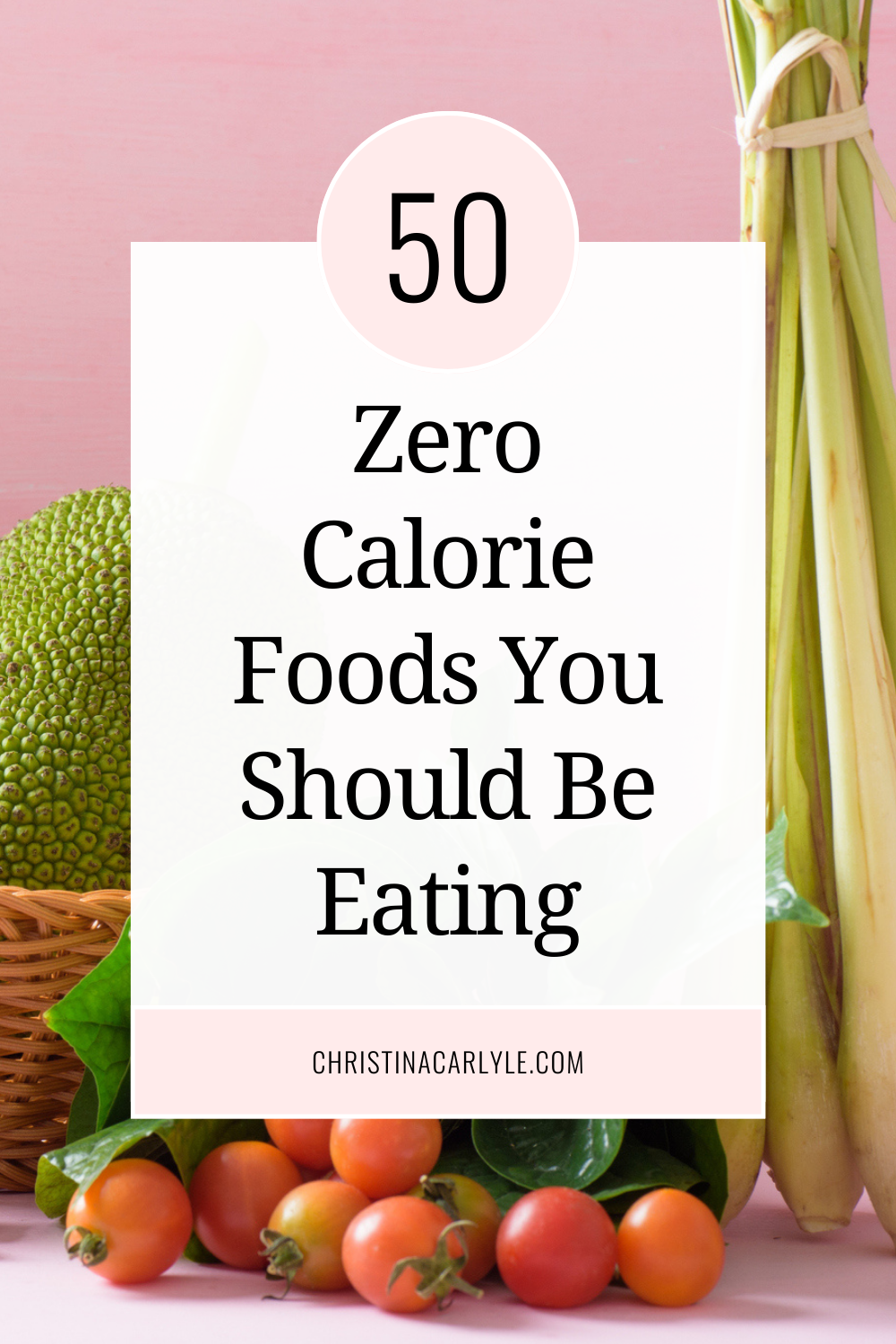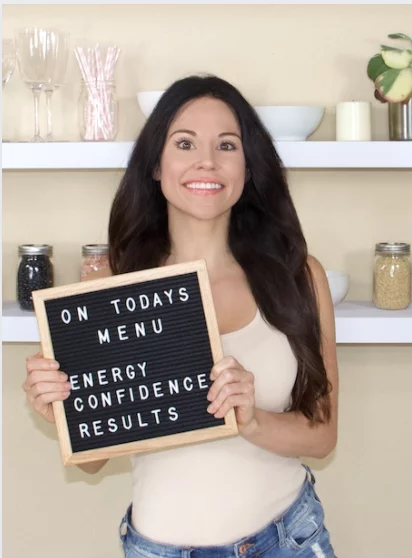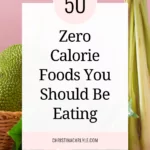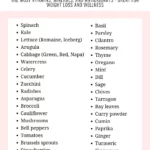Last Updated on July 17, 2023
Zero calorie foods are a tool I use to get people fit and healthy with the most delicious food possible. I find that not many people know about zero calorie foods so I’m breaking down everything you need to know so you can use them to get incredible results.
You’ll learn:
- What Zero Calorie Foods Are
- Their Benefits
- 50 of the Best Zero Calorie Foods for Weight Loss and Health
- How to Eat Them to Get the Best Results
Let’s do this.
What are Zero Calorie Foods?
Zero calorie foods are foods that are extremely low in calories. These foods are often referred to as “negative calorie foods” because the energy required to digest, metabolize, and eliminate them is the same or higher than the calories they provide. Because calorie intake is balanced out by energy exertion during digestion eating these foods means you had ‘zero calories.’ Make sense?
Bottom line when you eat zero-calorie foods you burn off what you put in automatically. So that’s how these foods got their name…
That’s also why zero-calorie foods are great for weight loss or for anyone wanting to be conscientious of calorie intake without meticulous calorie counting.
But that’s not the only reason why they’re so beneficial and smart!
Zero Calorie Food Benefits
Zero calorie foods are typically very high in water content and fiber, which makes them filling and hydrating. The fiber and water content helps to create a sense of fullness without a significant amount of calories in your diet.
Eating zero calorie foods also helps boost hydration. Remember, you don’t just drink water, you can also eat it… but eating high water foods helps you absorb the nutrients from the foods better. It also aids in the detox and digestion processes of the body.
The best part? Zero calorie foods are typically low in macronutrients such as carbohydrates, proteins, and fats. But, they’re often very high in micronutrients, including vitamins, minerals, and antioxidants. These beneficial miconutrients are essential for maintaining overall health and supporting various bodily and metabolism functions.
While zero calorie foods can be a valuable addition to a healthy diet, it’s important to note that they should not be relied upon as the sole source of nutrition. A well-balanced diet should include a variety of foods from different food groups to ensure you are getting all the necessary nutrients your body needs.
Every cell in your body requires all macronutrients (fat, carbs, and proteins) and an appropriate amount of energy (calories) needed to sustain metabolic and bodily functions.
Eating a majority of zero calorie foods exclusively would cause macronutrients and energy deficiencies that would cause metabolic dysfunction, causing the metabolism to slow and make fat more stubborn, and affect health and energy levels.
20 Best Zero Calorie Foods
These foods are not only low in calories but also packed with vitamins, minerals, and antioxidants that provide various health benefits.
Here are 20 zero calorie foods with the most nutrients and least calories per serving, ranked from highest to lowest.
- Spinach:
- Serving Size: 1 cup (30g)
- Calories: 7
- Micronutrients: Vitamin A, Vitamin C, Vitamin K, Folate, Iron, Calcium
- Kale:
- Serving Size: 1 cup (67g)
- Calories: 33
- Micronutrients: Vitamin A, Vitamin C, Vitamin K, Folate, Calcium, Potassium
- Lettuce (Romaine, Iceberg):
- Serving Size: 1 cup (47g)
- Calories: 5
- Micronutrients: Vitamin A, Vitamin K, Folate
- Arugula:
- Serving Size: 1 cup (20g)
- Calories: 5
- Micronutrients: Vitamin K, Vitamin C, Folate
- Cabbage (Green, Red, Napa):
- Serving Size: 1 cup (89g)
- Calories: 22
- Micronutrients: Vitamin C, Vitamin K, Folate
- Watercress:
- Serving Size: 1 cup (34g)
- Calories: 4
- Micronutrients: Vitamin A, Vitamin C, Vitamin K, Calcium, Iron
- Celery:
- Serving Size: 1 medium stalk (40g)
- Calories: 6
- Micronutrients: Vitamin K, Folate, Potassium
- Cucumber:
- Serving Size: 1 medium cucumber (301g)
- Calories: 45
- Micronutrients: Vitamin K, Vitamin C, Magnesium
- Zucchini:
- Serving Size: 1 medium zucchini (196g)
- Calories: 33
- Micronutrients: Vitamin C, Vitamin B6, Magnesium, Potassium
- Radishes:
- Serving Size: 1 cup (116g)
- Calories: 19
- Micronutrients: Vitamin C, Folate, Potassium
- Asparagus:
- Serving Size: 1 cup (134g)
- Calories: 27
- Micronutrients: Vitamin A, Vitamin C, Vitamin K, Folate
- Broccoli:
- Serving Size: 1 cup (91g)
- Calories: 31
- Micronutrients: Vitamin C, Vitamin K, Folate
- Cauliflower:
- Serving Size: 1 cup (100g)
- Calories: 25
- Micronutrients: Vitamin C, Vitamin K, Folate
- Mushrooms:
- Serving Size: 1 cup (70g)
- Calories: 21
- Micronutrients: Vitamin D, Vitamin B2, Selenium, Potassium
- Bell peppers (Green, Red, Yellow, Orange):
- Serving Size: 1 medium pepper (119g)
- Calories: 24
- Micronutrients: Vitamin C, Vitamin A, Vitamin B6
- Tomatoes:
- Serving Size: 1 medium tomato (123g)
- Calories: 22
- Micronutrients: Vitamin C, Vitamin A, Potassium
- Brussels sprouts:
- Serving Size: 1 cup (88g)
- Calories: 38
- Micronutrients: Vitamin C, Vitamin K, Folate
- Strawberries:
- Serving Size: 1 cup (152g)
- Calories: 49
- Micronutrients: Vitamin C, Manganese, Folate
- Blueberries:
- Serving Size: 1 cup (148g)
- Calories: 84
- Micronutrients: Vitamin C, Vitamin K, Manganese
- Raspberries:
- Serving Size: 1 cup (123g)
- Calories: 64
- Micronutrients: Vitamin C, Vitamin K, Manganese
Remember, although these foods have negligible calories, it’s important to consume a variety of foods from different food groups to meet all your nutrient and calorie requirements.
I recommend having 1-2 servings of these zero calorie foods paired with your favorite clean, lean proteins, other veggies, and healthy fats.
I also recommend adding a TON of zero calorie herbs and spices into all of your meals.
Pin this list to Pinterest so you’ll have it forever
Zero Calorie Herbs & Spices
Herbs and spices are also high in micronutrients and low in calories. Although most have fiber they don’t contribute much towards macronutrient count… Although macronutrients are low they’re packed with micronutrients and fresh flavors.
So I don’t consider them zero calorie ‘foods’ but instead I like to think of them as ‘flavors’ that just so happen to have a TON of nutritional benefits with negligible calories. A lot of the following zero calorie herbs and spices have been used in healing protocols for centuries by different cultures.
They add depth, flavor, and aroma to your dishes without contributing significant calories. Enjoy experimenting with different combinations to enhance the taste of all of your meals while keeping the calorie count low.
I always tell my clients to eat as many of these ‘flavors’ as they want. The more the merrier… because when you layer on different flavors it helps trick the brain into feeling fuller faster (on less food) and helps regulate hunger and blood sugar levels which is great for weight loss and wellness. So like I said… the more the merrier.
For the best results try to use at least 3 of the following herbs and spices to add beneficial nutrients, compounds, and flavors to each of your meals. Make sure you’re eating the foods above and the herbs and spices below… I recommend both in all meals.
- Basil
- Parsley
- Cilantro (Coriander)
- Rosemary
- Thyme
- Oregano
- Mint
- Dill
- Sage
- Chives
- Tarragon
- Bay leaves
- Curry powder
- Cumin
- Paprika
- Ginger
- Turmeric
- Cinnamon
- Nutmeg
- Black pepper
- Cardamom
- Cloves
- Allspice
- Mustard powder
- Chili powder
- Garlic
- Onion powder
- Fennel seeds
- Saffron
- Celery seeds
How to get the Best Results
Remember to have at least 1 serving of a zero calorie food and at least 3 servings of herbs and spices into every meal.
Again, it’s important to note that these zero/negative calorie foods and flavors don’t contribute much in terms of macronutrients. If you want to see noticeable improvements in your physique, health, mood, and energy levels, you have to balance macronutrients and micronutrients. Otherwise, you can cause metabolic dysfunction that can lead to a TON of pesky symptoms that can affect your health and ability to lose weight.
I have a free assessment and training all about metabolic dysfunction, how it makes you fat, sick, and sad, what causes it, and how I reverse it quickly. Check it out if you’re struggling to look and feel your best.
xo
Your Coach and Biggest Cheerleader,
![]()
PS. Subscribe below so you won’t miss my next free training.
If you liked this post you’ll love these articles:
- Healthy Cooking Oil Guide
- Best Fruits for Weight Loss
- Best Anti Inflammatory Foods and Supplements
- Protein Intake Calculator
- Water Intake Calculator
- Best Foods for Gut Health and Weight Loss

